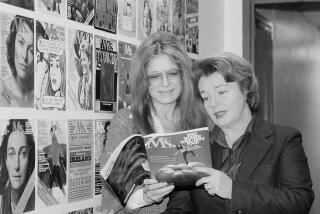Jane Maas’ book recalls her ‘Mad Men’-era career in advertising
- Share via
“Does she or doesn’t she?” — the innuendo-filled catchphrase for Clairol from 1956 easily could have been conceived by “Mad Men’s” Don Draper.
It was not, of course, but rather was penned by one of the few female copywriters of her day. Jane Maas, also a pioneer in the nearly all-male world of advertising decades ago, pays homage to the hair color campaign by Shirley Polykoff in her new book, “Mad Women: The Other Side of Life on Madison Avenue in the ‘60s and Beyond.”
A witty, personal account of the “real life Peggy Olson,” Maas details her climb from copywriter to creative director at Ogilvy & Mather to “Advertising Woman of the Year” for her work on the famous “I Love New York” campaign.
Maas admits she was not a fan of “Mad Men” at first. “It’s grown on me,” she said by phone interview from her home in New York, where she was happy to point out what they get right (and wrong) in the Emmy-winning AMC show, which begins its fifth season Sunday.
Was there really that much sex at the office? Yes. Was there really that much booze and cigarettes? “Yes and yes,” reveals the once-two-pack-a-day smoker.
Maas did take issue with a scene from the first season where a hung-over Don strolls into the agency at 9 a.m. and Roger Sterling asks if he has the big idea ready for their meeting with a big client. Don says “Not yet, but I will.”
“Oh, please!” shrieked Maas. “If we didn’t have a big idea the night before we would work all night long, otherwise we’d figure out a way to postpone the meeting.”
Her career offers a possible path for the TV character Peggy. “If they want to keep the realism in the show they need to hire a few more copywriters or promote Peggy to assistant creative director,” said Maas of the lack of female peers on the show. “Or I predict she’ll leave to go to another agency or start her own.”
Although Maas and Olson share the same drive to succeed in a male-dominated industry, Maas wishes Peggy were more relaxed and not so prickly when people criticize her copy.
The mother of two said she relates more to Roger Sterling than Don Draper. “Roger is more like [her boss] David Ogilvy in terms of being debonair and able to woo clients. “David was gorgeous and so charming with that British accent.”
“Mad Men” does get Peggy and Joan’s wardrobes spot on, but she added that gloves were obligatory and they always wore heels. “Once a woman became a copywriter she wore a hat in the office all day.”
Just like the staff at Sterling Cooper Draper Pryce, Maas had her share of difficult-to-please clients, such as “the Queen of Mean,” Leona Helmsley, “the most miserable, abject, cravenly seven months I’ve had in my whole life.” Surprisingly, children’s author Roald Dahl, husband of actress and Maxim Coffee spokeswoman Patricia Neal, turned out to be a challenge as well. (Coincidently, he and Ogilvy worked together at British intelligence during World War II.)
“I’d talk with him on the phone, and he’d leave me sputtering with indignation,” Maas recalled. “He made the outrageous demand that he be paid residuals because he was an unseen presence when Pat talks about her wonderful husband in the spots.”
Maas said no, they’d write him out of the scripts, but the client (General Foods) gave in.
There’s mention of a young F. Murray Abrahamwaxing (or wiping) poetic in his first commercial for Whistle Spray Cleaner and fellow Bucknell University alumni, novelist Philip Roth’s occasional calls consulting with her while writing “Everyman,” which has as its lead character an advertising man.
Maas also discusses the pressures on her family life and struggles being just one of two full-time working moms in her daughter’s class. “Men felt sorry for us, thinking we must be married to some real bums.”
Although “Mad Men” accurately portrays the glamorous side of the business, the one thing the show doesn’t capture was how much fun they had. Said Maas: “Despite all the shenanigans and distractions, we loved our jobs.”
More to Read
The biggest entertainment stories
Get our big stories about Hollywood, film, television, music, arts, culture and more right in your inbox as soon as they publish.
You may occasionally receive promotional content from the Los Angeles Times.










